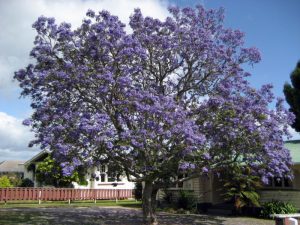The Iconic Jacaranda Trees of Long Beach
 The jacarandas of Long Beach are among the most iconic trees in southern California. In addition to growing well in the climate of the area, they are some of southern California’s most eye-popping trees – at least for a month or so. But even for all of the beauty and benefits they provide, some residents wish the jacarandas would all go away.
The jacarandas of Long Beach are among the most iconic trees in southern California. In addition to growing well in the climate of the area, they are some of southern California’s most eye-popping trees – at least for a month or so. But even for all of the beauty and benefits they provide, some residents wish the jacarandas would all go away.
Jacaranda Basics
Blue jacarandas – known to botanists and arborists as Jacaranda mimosifolia – originally hail from central South America, but they’re currently cultivated in suitably warm climates all over the world. They do not tolerate freezing temperatures well, but hardy, established trees often survive temperatures as low as 20 degrees Fahrenheit.
Jacarandas occasionally reach about 60 feet in height or so, and they often develop a round or vase-shaped canopy. Because of their typical growth habit, they were often planted on both sides of a street, which creates something of a closed canopy.
Jacarandas grow best in areas with deep, fertile soils, and plenty of direct sunlight. Because they do not tolerate excessively dry soil, it is important to provide supplemental irrigation during dry spells. Additionally, you’ll want to provide this water in the appropriate manner (high quantity / low frequency) so you can encourage the development of deep root systems.
The Magical Month of May
Despite their many positive traits that led to their popularity, jacarandas are most famous for their glorious blue flowers which usually burst forth in late April or May. During this time, the purple-blue flowers dominate the landscape and create a truly amazing aesthetic that lasts for about a month or two.
The individual flowers grow to about 2 inches in length and are borne on foot-long panicles (stalk-like structures). A number of bee species are attracted to the fragrant, trumpet-shaped flowers, where they assist in pollination duties.
A Love-Hate Relationship
It is hard to argue that jacarandas in bloom are jaw-droppingly beautiful. But soon enough, the flowers will have served their purpose, and the trees will begin carpeting the ground in blue petals as the fruits begin to mature. Given the high number of flowers on jacaranda trees, this causes quite a mess.
Homeowners living under jacaranda canopies frequently complain about the shed petals, which end up everywhere. They fill up rain gutters, cover up drainage grates and find their way into homes, where they may stain light-colored carpets. Some residents are even forced to use blowers to clear away the thick layer of petals covering their property.
But this frustration eventually comes to an end, as the petals finally disappear, and the jacarandas fill their canopies with gorgeous green, feathery foliage. And this causes many to forget about the headaches they briefly cause after flowering until a year passes, and they’re faced with another mess to clean up.
***
If you need help caring for your jacaranda trees, or you are considering installing some on your property, give your friends at Evergreen Arborist Consultants a call. Jacarandas grow really well in Long Beach, Beverly Hills, Santa Monica and the rest of the greater Los Angeles area. Let us help beautify your yard today!

